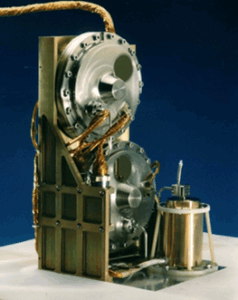Andrew Gibson, Head of Space Mechanisms, attended the 25th Anniversary Meeting of the MOPITT to celebrate Long-lived Space Mechanisms for Monitoring Pollution from Space. Andrew provided notes on some of the key points on the event.
It was a pleasure to participate in the 25th Anniversary Meeting for the MOPITT Instrument (Measurements of Pollution in the Troposphere) flying on the NASA Terra platform earlier this month, held on 10-11th of April. This meeting, hosted by CSA and well attended by NASA, NCAR and many others, was a rare opportunity to recap experiences from my first ever space project and to summarise key lessons from the early days of development of the instrument, and then to give an overview through its lifetime operating in orbit over such a long period of 25 years.”

MOPITT Instrument – In Test at University of Toronto
This meeting held at CSA celebrated many achievements of a Canadian space instrument that met and exceeded expectations in many ways:
- Produced the first ongoing and longest satellite record of CO distribution in the atmosphere over 25 years (2000-2025)
- Longest continuously operating Canadian space mission in history!
- Allowed to study seasonal and annual variability and long-term trends of CO
- Observed many global transport events, including from fires and cities
- Determined various aerosol sources and plume heights
- Estimated chemical emissions for fossil fuel use, fire and biogenic sectors
- + much more science (hydroxyls, etc)
The development of this amazing gas spectroscopy radiometer required the development of unique long-life mechanisms to enable its function. Reliable mechanisms were needed to provide cooling, to modulate incoming light and the gas path length (acting as a means of optical filtering) and to open port cover doors once in orbit. I’m particularly proud to have been the lead designer for the Length Modulator Cell mechanisms during my time at COM DEV Space Group (now Honeywell), but also having made contributions to characterise the cryocoolers and pressure modulator cells during my time at the University of Toronto, prior to joining COM DEV.
In my talk (given remotely), I recalled advice received in those formative days working at COM DEV, which included consultations with experts from ESTL, NASA and Draper Laboratories. Little did we know it, but we would go on to choose a new class of lubricants that remain at the forefront of space technology today, going on to produce some of the longest lifetimes of mechanisms ever to operate in orbit, accumulating between 8 and 21 billion revs each of 7 continuously rotating devices on board. And little did I realise that I would come to work with ESTL in the UK so many years later, having been forever influenced by my early interactions with their staff, Rob Rowntree and Steve Gill.
This forum, allowed me to highlight how ESTL and others continue to reference the MOPITT mission as a key set of data points for good lubrication, citing it as an example of what can be achieved with liquid lubricated bearings. I went on to highlight how ESTL continues to work to understand what makes MAC lubricants (multiply alkylated cyclopentane) so special for achieving long lifetimes in space. Such work is continuing to make use of our various tribometers to better understand factors affecting lifetime, including the effects of oil additives. By understanding the key factors, we stand a better chance to repeat and improve on such successes to enable many future missions.


Length Modulating Cells (LMCs) and Chopper Mechanisms
Left: 2 of the 4 LMCs are shown mounted to a supporting structure, with pressure sensors on each and a molecular sieve to control the gas pressure for one LMC, Right: Rotating Vane Chopper (1 of 4)

Length Modulated Cell – isometric view
A single brushless motor drives bowtie shaped rotors in each of 2 separate cells (one holding the gas of interest), via a magnetic coupling operating through a thin central wall.
Sadly, at the same CSA meeting, it was announced that, despite the instrument being in overall good health, a decision had been made by NASA and CSA to turn-off the instrument due to power restrictions of an aging spacecraft, having been degraded by various micro-meteorite impacts over the years.
However, the achievement of the TERRA satellite including MOPITT and 4 other instruments on board, speaks for itself, especially when one considers that the original plan was to have 3 platforms to achieve an 18 year mission. It was recounted by the NASA director that as things have played out, budget restrictions led to the cancellation of the 2nd and 3rd EOS platforms, and yet the original platform renamed as Terra exceeded the overall programme goals by >7 years, with all 5 instruments collecting an invaluable 25 year dataset, while at least 3 of the instruments will carry on for up to 2 more years.
This programme has clearly contributed to a greater understanding of climate change including many anthropogenic influences on the Earth, but it has also served to push forward the envelope of what is achievable with long-life mechanisms. ESTL and ESR Space remain committed to push the envelope of mechanisms lifetimes by exploiting such advances for the benefit of the wider space industry.
Additional information:
https://www.asc-csa.gc.ca/eng/satellites/mopitt.asp
https://www.esmats.eu/amspapers/pastpapers/pdfs/2016/gibson.pdf